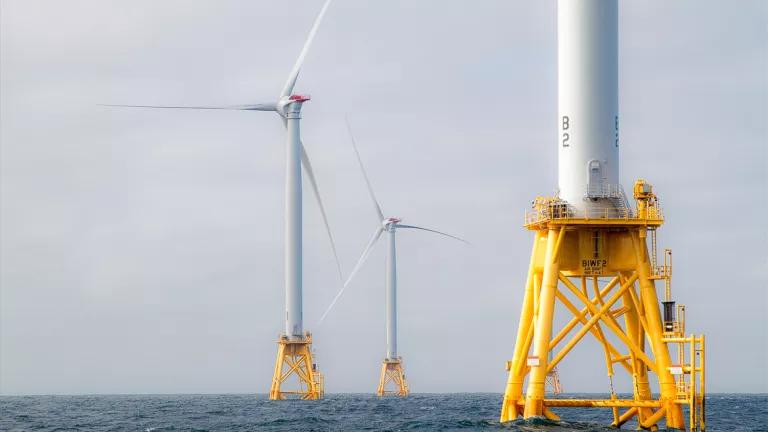Top 3 Take-Aways on Electric Vehicles from COP-26
Some of the biggest announcements were made last week at the COP-26 in Glasgow on “Transport Day.” The focus: zeroing out pollution from some of the world’s dirtiest and climate-busting sources including cars, trucks, ships, 2- and 3-wheelers, and planes.

Some big announcements were made last week at the COP-26 in Glasgow on “Transport Day.” The focus: zeroing out pollution from some of the world’s dirtiest and climate-busting sources including cars, trucks, ships, 2- and 3-wheelers, and planes. I’ll discuss what happened and the lessons from conversations with other transportation experts and partners, with whom I’ve had the privilege talking to in Scotland together with my colleagues Charu Lata from our India Program and Mona Yew from our China Program. NRDC's President, Manish Bapna, has discussed what was achieved at the COP and what's still needed, while my colleague, Jake Schmidt, has provided a run-down of those commitments and the need to deliver.
Destination: 100% Zero-Emission Transport
One of the biggest announcements on Transport Day was the declaration by governments, businesses, and investors committing to all new passenger cars and vans being 100% zero-emissions no later than 2035 in leading markets, followed by the rest of the world by 2040. (See are reaction here). Over 30 national governments (including the United Kingdom, Canada, India, Poland, Uruguay, and even Kenya and Cambodia), signed together with numerous sub-national governments including the states of New York, Washington, and California, together with six large automakers (Ford, GM, Volkswagen, Mercedes-Benz, BYD Auto, and Jaguar Land Rover), and numerous corporations with large fleets. The largest auto manufacturing countries, including Japan, the United States, Germany, and China were noticeably absent from the agreement, as well as companies such as Toyota. Having additional state and non-state actors sign on will be an important step forward. The Biden Administration had previously announced in August an Executive Order to reach 50% electric vehicle sales by 2030 in the U.S.
Other major announcements included the United States and thirteen other countries from Britain, to Panama, and Norway, agreeing to new emission-cutting goals for shipping starting in 2023, to be pursued through the International Martine Organization, together with a 2050 target of achieving net-zero emissions by 2050. This was matched by leading companies organized by the U.S. under “First Movers Coalition” who committed to having 100% of their medium-duty trucks purchases or contracts be zero-emitting by 2030, as well as 30% of new heavy duty truck purchases. The coalition also announced goals to have 10% of the freight volume on their international ships and carriers transported by zero-emission fuels by 2030. On the aviation front, new goals for air transport to use low-carbon aviation fuels were announced, together with use of propulsion technologies powered by electricity or hydrogen.

The 100% Zero Emissions Express: What’s the Fastest Way There?
A rich dialogue among stakeholders, government officials, and the private sector proceeded the announcements at the COP around what policies each jurisdiction should adopt to realize the 100% commitments.
Together with an array of diverse partners who are part of the Drive Electric Campaign, NRDC is working to have the jurisdictions we work in transition to 100% electric-drive for all new 2- and 3-wheelers and buses no later than 2030, passenger vehicles by 2035, and commercial trucks by 2040. Curbing the worst impacts of climate pollution that threatens public health and the very ecosystems we depend on requires nothing less. The good news is that, among the many stakeholders I had a chance to talk with, we actually know what the solutions are, what needs to be done, and how fast change can look (thank you to our Norwegian colleagues for making 90% electric vehicle sales look so easy!).
But policymakers and stakeholders alike must move with greater speed, scale, and ambition to meet and exceed the commitments being announced. Here are some of some of the take-aways from my conversations in Scotland.
1. One of the top drivers for EV sales in leading jurisdictions is manufacturer supply policies, such as zero-emission vehicle requirements and vehicle emission standards.
One of the top reoccurring themes at numerous meetings: leadership jurisdictions have established strong GHG and zero emission standards for vehicle manufacturers, resulting in introduction and robust supplies of new, attractive electric vehicle (EV) products. In turn, those introductions have led to tremendous increases in sales of EVs over the past two years. These EV products are often mainly available, and offered first, in the jurisdictions that are essentially requiring them through standards.
In the European Union and the UK, these standards have taken the form of binding CO2 emission limits on vehicles. In China it’s the New Energy Vehicle requirement. In the U.S. it’s the Zero Emission Vehicle (ZEV) standards that have been adopted or are under consideration by 17 states for passenger vehicles, together with analogous Advanced Clean Truck standards for commercial trucks. All the policies have the common result: they ensure manufacturers are producing and introducing a minimum share of electric vehicles into the consumer market (or for fleets).
In Western Europe, where the GHG emission standards became more binding in 2020, about twice as many EV models are now being offered by automakers compared to the U.S. This helped lead to numerous jurisdictions in Western Europe zooming from less than 5% sales in 2019 to exceeding 20% sales in the first half of 2021 (leaving my home state of California in the dust at just over 10% sales). In September alone, EV sales approached 30% of the market in Germany and exceeded 90% in Norway! California is now looking to increase its ZEV requirements for model year 2026 and onwards to catch-up with other jurisdictions and market leaders.

My test-drive of Hyundai’s new Ionic 5 battery electric vehicle in Scotland at the Arnold Clark Innovation Centre. Available in Scotland, but not in the U.S. currently.

Warning! Vehicle Supply “Push” May Lead to Rapid Take off of EVs. Data Source: IEA Global EV Explorer
2. Charging infrastructure: plan for the majority adopter and 100% sales sooner rather than later.
Ubiquitous access to charging, starting at the home, will be a key enabler of achieving a 100% electric drive fleet. In speaking to and hearing from representatives including the Norwegian EV Association, ZEV Alliance, ICCT, Forth, and city representatives in Scotland, EVNoire, among many others, some important takeaways for policymakers in planning for infrastructure include:
- Clear the way to overcome the apartment or multi-unit dwelling challenge, where the tenant or renter does not necessarily own the parking spot, by adopting “right to Charge” laws providing residents with the right to install charging infrastructure, while also adopting laws to streamline permitting for building owners, and EV-readiness building codes requiring new parking spots to be charge-ready. In adding, we need to ensure the ability to have managed charging to facilitate growth. In Norway, it is not uncommon to see unmanaged charging solutions in apartment complexes needing to be replaced with managed charging solutions due to the rapid growth in EVs. We need to future-proof current investments.
- Prioritize charging infrastructure deployment in under-served communities, but also ensure those programs are linked to programs to get EVs into the hands of community-members. Ensuring that under-served populations and communities of color can also access EV ownership is critical to increasing equitable outcomes, growing the market, and also avoiding gentrification (e.g. infrastructure in buildings that can only be accessed by wealthier drivers). Incentives targeted for under-served populations, access to EV car-sharing, and other active transport services should be tied together with the charging infrastructure access programs
- Ensure a coordinated and reliable fast and ultra-fast charging network. While home-charging will continue to serve the majority of refueling needs, fast-charging stations will be important for EV user groups that have limited access to home charging or need to travel longer-distances. Ensuring universal, real-time knowledge of the location and status of those charging stations (e.g. which ones are occupied or in need of repair); having payment options that allow for the current credit card payment technologies as well as mobile payments, and expediting permitting and construction of stations to avoid projects stretching out to years are all important challenges that are needing to be overcome.
- Don’t forget about infrastructure for commercial trucks, vans, and 2- and 3-wheelers. While much focus has been on infrastructure for passenger cars, similar planning is needed for the various use-cases of commercial trucks and vans, including those vehicles that return to base (“depot” charging) as well as regional and long-haul charging that may not. For the 2- and 3- wheel segment so prevalent in Asia and Latin America for delivery services, battery swapping and convenient opportunity charging sites are important to incorporate.
- Allow for innovative solutions for EV drivers without dedicated parking or just want to "fill up," such as these chargers by Scottish startup Trojan Energy that can be removed after charging by the user, leaving no permanent raised street furniture on the sidewalk. Other companies have developed retractable chargers that disappear back into the sidewalk, or charging systems that can be incorporated into existing street lights.

No dedicated parking? No problem! Plug into the sidewalk and take your charger with you when done.
3. Make EVs cheaper to purchase compared to polluting vehicles, and more attractive to own and operate to boot.
Rapid cost reductions are occurring globally in EVs through economies of scale and innovation, with many studies pointing to various vehicle categories reaching cost-parity with internal combustion engine vehicles between the 2023-2030 timeframe. But even lower cost solutions are needed for low-income countries. Policymakers can accelerate the transition by helping ensure EVs cost less than a comparable polluting, internal combustion engine vehicle through:
- Enact fiscal measures that reward consumers and fleets who make the transition via direct purchase incentives, reduction in sales or registration taxes for EVs, together with elimination of any punitive EV fees. Some jurisdictions, such as France and Norway, also have systems that apply either pollution taxes or retain higher taxes for polluting vehicles.
- Make one dollar stretch to ten. The introduction of climate financing for zero-emission vehicles is urgent, as the vehicle and infrastructure costs remain a key barrier for many. Public-private financing mechanisms, such as the one proposed by NRDC, Calstart, and Southern California Edison can help stretch public investments by attracting far more in private capital investments to accelerate the transition.
- Ensure driving on electricity remains attractive. Stakeholders will need to work on policies and programs with regulators so the design of utility electricity rates work not only passenger vehicle users, but for commercial truck fleets. ensure refueling costs remain attractive remains important.
- Prioritize finite government investments to those that have the most need for incentives such as moderate and lower-income households. Doing so will deliver more equitable outcomes and lead to increased efficacy. It’s not rocket science: we know that the “purchase decisions of higher-income car buyers are far less sensitive to ZEV rebates than the purchase decisions of low- to moderate-income buyers.”
- Efforts must start now to assist low-income countries, where the timeframes for developing infrastructure, programs and policies need a head start, and where capacity and resources are often far more constrained compared to wealthy countries.
If you made it this far, I’ll leave you with a wonderful vision, depending on what side of the pond you live on. What if the experience of buying an EV were as easy as going to a convenient center, that allowed you to sit-in and test drive every EV model available without pressure to purchase, where you could get all your questions answered, and you could simply be connected with the dealership if you decide you’re interested?
I would say go to Scotland, where the largest dealership chain (Arnold Clark) worked with automakers to have all the models available to test-drive—even the BMWs and Teslas of the world that they don’t sell—with no salespeople or pressure at their Innovation Centre. That’s part of how we’ll get to achieving “Net Zero in the Automotive Industry,” which they have proudly hang up on their wall.
If they can start making the switch, we all can. Time to get moving.

Inside the Innovation Centre where you can “learn, charge, driven, and change to an EV” (Glasgow, Scotland)

Net-zero signage at Arnold Clark Innovation Centre (largest dealership chain in Scotland).




